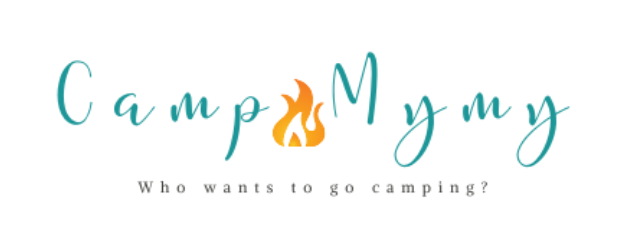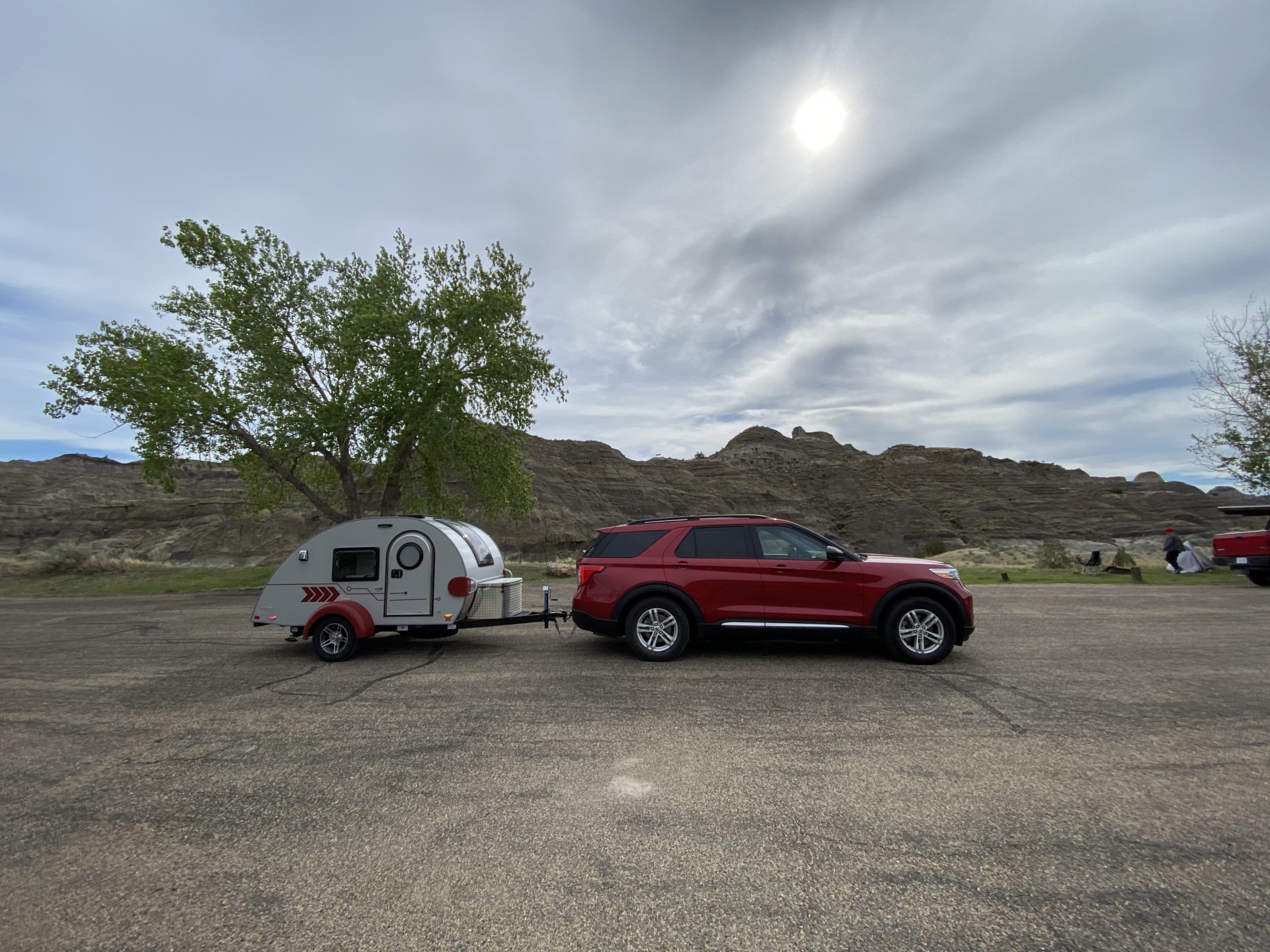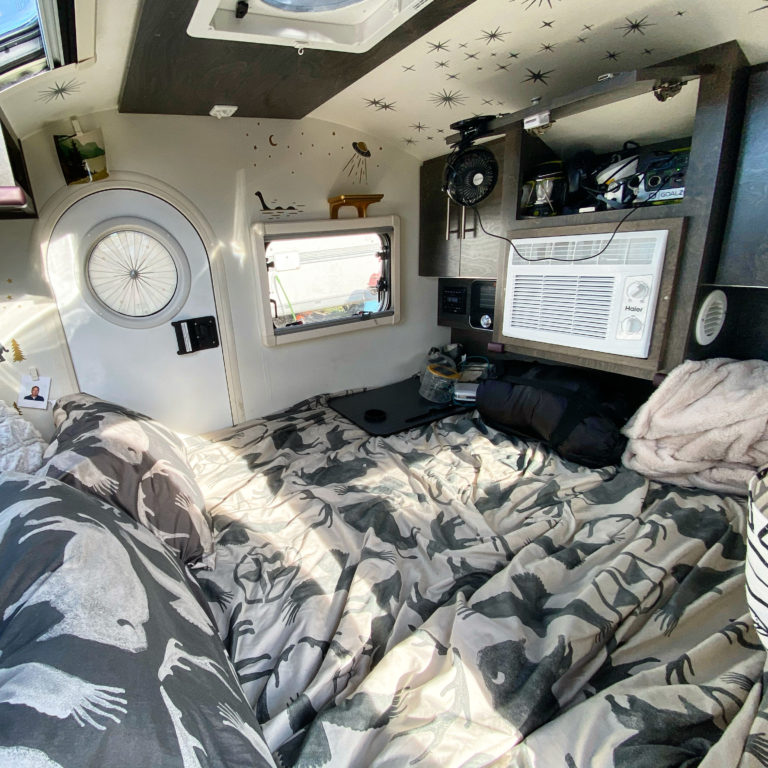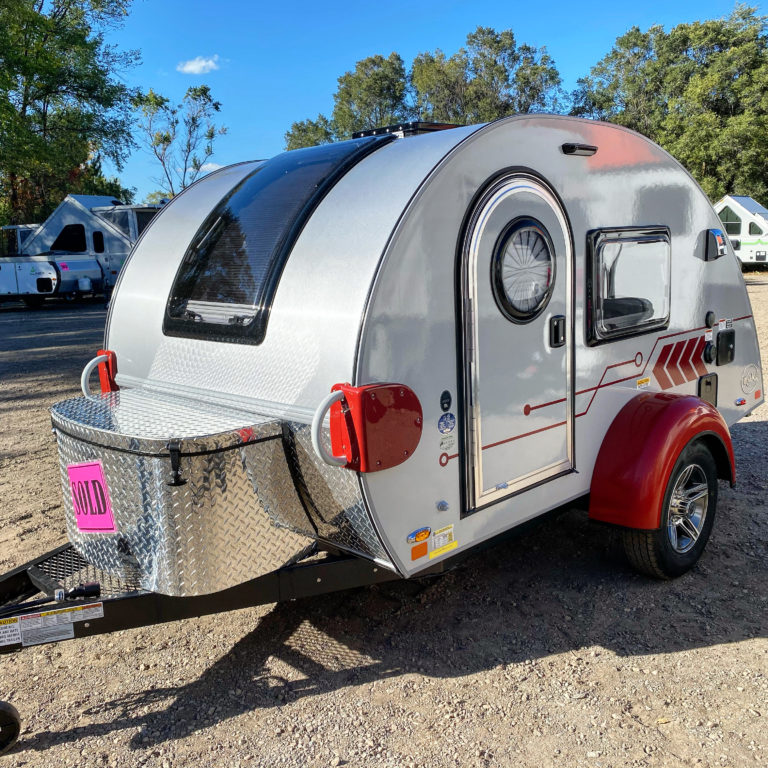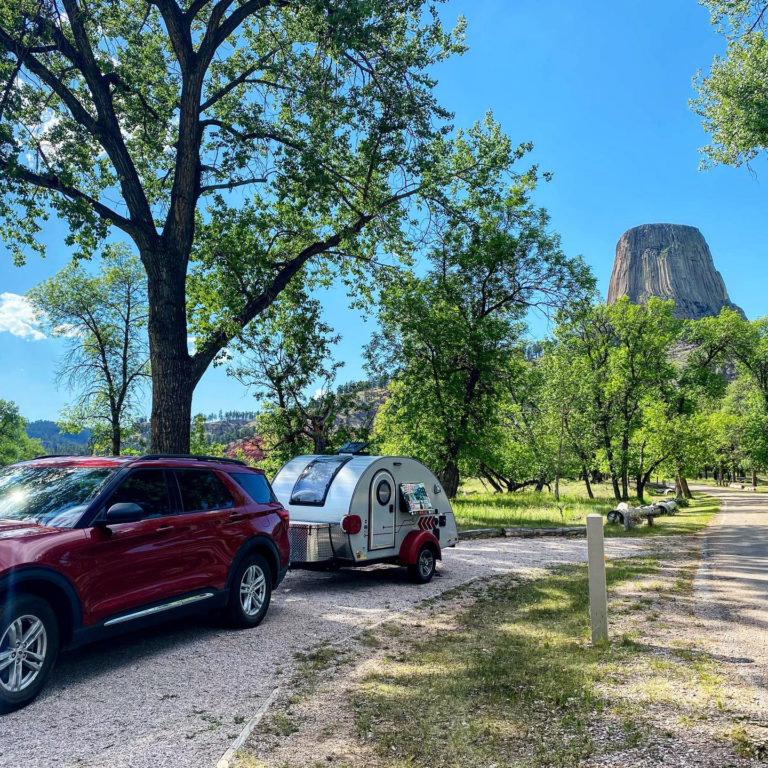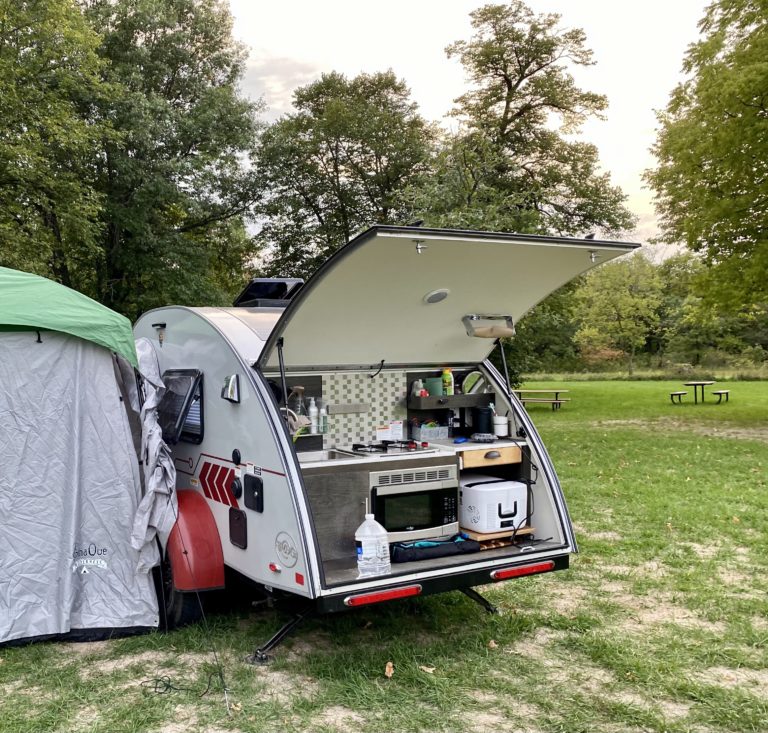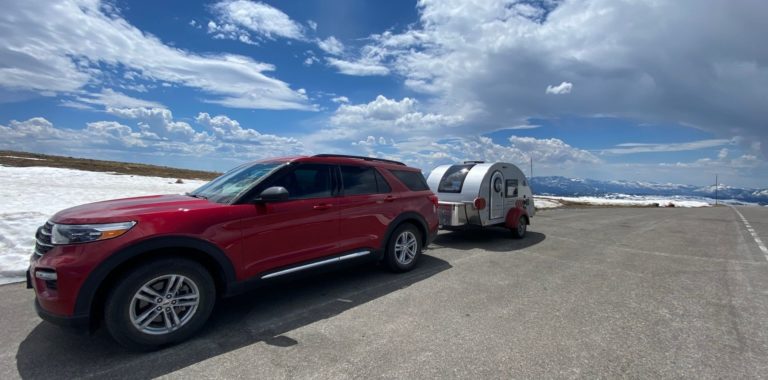Teardrop Camper Boondocking Essentials
The great thing about a small
Introduction to Boondocking with a Teardrop Camper
What is Boondocking?
Boondocking, also known as dry camping, is camping “off-grid” with no access to electric or water or sewer hookups. This means that you will have to carry your water with you, and you will have to either use your onboard camper battery for power, or be able to generate some power of your own.
Why Choose a Teardrop Camper for Boondocking
Despite their small size, teardrop campers come equipped with the essentials: sleeping space, a kitchen area, and storage. Many models also include basic power and water systems making them the perfect little “home on wheels” for boondocking.
Their compact size allows you to navigate tight roads and campsites, opening up a world of remote boondocking spots.
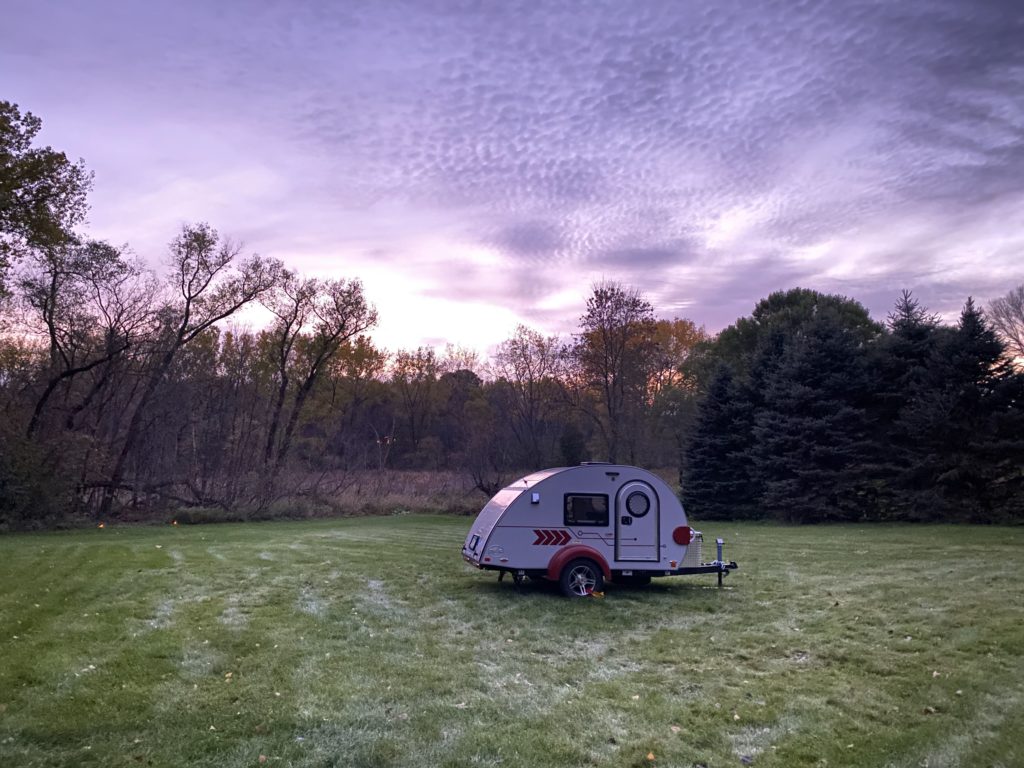
Where can you boondock with a teardrop Camper ?
Most people think of BLM Land or Bureau of Land Management land or National Forests when they talk about boondocking. Realistically boondocking can take place at any campground, parking lot or backyard where there are no hookups.
Researching Campsites and Rules
Camping on BLM Land is not necessarily free. There are BLM campgrounds that do charge a fee for camping. Some are first come first serve, others can be reserved through the recreation.gov website. Many of the US National Parks offer sites with no hookups, however they do have bath houses or at a minimum vault toilets in the campground. Be aware of what amenities are in the area before you set out to camp.
Research public lands, state parks, or designated free camping areas. Check local regulations, as some areas may have restrictions on camping duration or campfire use. Websites like FreeCampsites.net or apps like Campspot or Campendium can be invaluable tools.
Being a responsible camper always means leaving your campsite as pristine as you found it—or better. Follow the Leave No Trace principles, including packing out all trash, minimizing campfire impact, and respecting wildlife.
Dispersed Camping
Dispersed Camping is camping on Public Land that is not a developed campsite or recreation area. There are many rules surrounding dispersed camping, including the 14 day rule – you cannot camp for more than 14 days in the same area in a 28 day period. This is to discourage people from living full time in one site.
Each state also has a Department of Natural Resources (DNR) or other local bureau that controls dispersed camping in State Forests and other public land and natural areas.
Preparing for Teardrop Camper Boondocking
Inspect your trailer
A reliable camper is the backbone of a successful boondocking trip. Take the time to inspect every inch of your
Planning for the Season and Weather
You will want to check the weather forecast before your trip so you can prepare for any surprises. Pack accordingly, whether it’s extra blankets for cool weather or sun protection in the summer. Consider packing a weather radio or satellite radio for your trip. Read more here about staying warm in your teardrop camper.
Comfort and Safety Essentials while Boondocking
Safety should be a top priority while camping off-grid. A few well-chosen tools can make a big difference in emergencies. For example a fire extinguisher should always be carried in your camper.
First Aid Kit
Carry a first aid kit with essentials like bandages, antiseptics, pain relievers, and don’t forget to bring any medications you take daily. Include items for outdoor-specific issues, such as insect bite treatments and blister pads.
Emergency-Kit - Orange 273Piece Camping Equipment for Camping Hiking Home Travel YIDERBO
Navigation and Communication Devices
In remote areas, cell service might be unreliable. A GPS device or offline maps app is essential for navigation. Two-way radios or satellite communicators provide a lifeline in case of emergencies.
Water Management
If your teardrop has a fresh water tank, make sure that it is sanitized and clean before you leave. If you don’t have a tank you will need to bring jugs of water. Research beforehand if the camp ground has potable water or where you can get more water nearby.
When boondocking, the general rule of thumb is to allocate 2 to 4 gallons of water per person per day. This estimation includes water usage for drinking, cooking, cleaning, and basic hygiene. However, the exact amount you need depends on factors such as climate, activity level, and individual habits.
Tips to Conserve Water While Boondocking
- Use Biodegradable Wet Wipes: Great for quick cleaning and minimizing water use for hygiene. Make sure you dispose of them properly, do not leave at the campsite even though they are biodegradable.
- Reuse Water When Possible: Collect and reuse grey water for flushing portable toilets (if permitted) or putting out the fire.
- Adopt Water-Saving Techniques: Wash dishes in a small basin and rinse using a spray bottle.
- Choose No-Cook Meals: Reduce the need for cooking and dishwashing by opting for sandwiches or other no-cook meals.
By planning carefully and practicing conservation, you can stretch your water supply.
Grey water (from washing or cleaning) should be disposed of without harming the environment. Use biodegradable soaps and collect the water in a portable tank or container. Dispose of it in designated areas when possible.
Using the bathroom while boondocking
If your camper does not have a bathroom, you will need to make a bathroom to use while boondocking. Your bathroom can be as simple to having a small bucket with a lid in your tent or camper, to having a separate privacy tent with portable toilet and shower. Be familiar with the camp site rules, some campgrounds do not allow a shower tent. Check out our guide, How to Build a Portable Bathroom for Camping for more information.
What do you use for power when boondocking?
Since the term “boondocking” means not having any electrical or water hookups, you will not have electricity for power. Many campers already have a battery and a propane tank, when boondocking you will need to keep a close eye on your battery and propane levels.
Solar power is one of the easiest way to charge your battery, so that you have enough electricity to use for lighting and to charge your phone and laptop and other items. Some campers have a built in solar panel used to charge the on board battery, others have a plug to attach a portable solar panel to the battery. Even if you don’t have a built in adapter, you can hook up a charger and panels to your battery.
Having a solar “generator” or power station will give you another way to store solar energy. The power station can be charged via A/C at home, with a car charger while driving, and with solar panels when boondocking. There are many good options for solar power stations, I use the Goal Zero brand. The longer you are out boondocking the larger you will want your power station to be.
Your power for heat and cooking can come from propane. There are portable heaters such as the Mr Buddy heater that run on propane, just be sure to have proper ventilation whenever running a heater. It’s important to have a carbon monoxide detector, smoke alarm and fire extinguisher whenever you are using a heater or cooking in your tent or camper.
If you would like to be able to run your air conditioner and other high powered appliances that won’t run on battery power only, you will need a gas generator. These can be loud and some areas do not allow them, or may restrict the hours you can run them. Never run a gas generator inside of your camper.
Cooking While Boondocking
Even if your camper has a kitchen, you may still want to make accommodations for boondocking, such as using a 12v portable refrigerator or bringing a small portable stove.
Essential Gear for Teardrop Camper Boondocking
Having the right gear ensures your comfort and safety while off-grid. Here’s what you’ll need:
- Water Supply
- Large water jugs or containers
- Water purification system (tablets, filters)
- Power Solutions
- Solar panels and/or portable generator
- Extra batteries or power bank
- Charging cables for devices
- Cooking and Food Storage
- Portable stove or grill
- Propane or fuel canisters
- Cooler or 12v portable fridge
- Cooking utensils, pots, and pans
- Non-perishable food supplies
- Paper towels or dish towel
- Cleaning Supplies
- Trash bags
- Sleeping
- Sleeping bags suited for the temperature
- Additional blankets or comforters
- 12V Heated Blanket
- Pillows
- Clothing and Personal Items
- Weather-appropriate clothing (layers, rain gear)
- Toiletries and personal hygiene items
- Medication
- Sunscreen and insect repellent
- Towels and washcloths
- Safety and Navigation
- First aid kit
- Multi-tool or knife
- Maps and GPS (offline maps if possible)
- Flashlights or headlamps
- Fire extinguisher
- Entertainment and Miscellaneous
- Books, games, or other leisure items
- Camera, SD Cards and batteries
- Camp chairs and table
- Shower Tent and Toilet
- Canopy, awning or tarp to block the sun
- Camera or binoculars
- Notepad or journal
- Communication
- Cell phone and satellite communicator
- Emergency contact information
- Local area information (nearest hospital, ranger station)
You can tailor this checklist based on the specific needs of your trip, including duration, weather, and your personal preferences.

